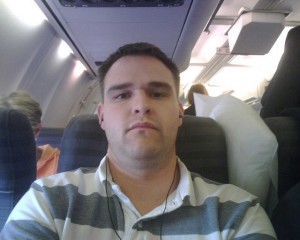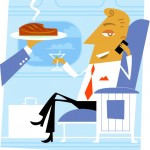You probably missed the New York Times photograph that showed a revealing picture of New Yorkers riding into work on commuter trains. The photographer stood behind a long series of rows, three seats to a row. In the photo, every window and aisle seat — and not ONE middle seat — is occupied. The train is otherwise crowded; the aisles are jammed with standees — all of them ignoring the available middle seat.
Some people are even sitting on the floor.
The accompanying story explores why Americans despise center seats, just brushing the unavoidable fact that many of us are, shall we say, rather husky. If I’m not mistaken, U.S. airline passengers will sometimes even pay extra for an aisle or window seat, just to avoid being the salami in a travel sandwich in which the “buns” all too often press right into the middle person’s space.
There was a time when one U.S. carrier, Southwest, got brisk business by offering dirt-cheap prices — with a catch:
Seats were not reserved, so when the passengers were released to board the airplane, the scene resembled a bison stampede. Frantic passengers elbowed aside little-old ladies just to get a window seat, pushed toddlers to the tarmac to claim one on the aisle, and made big-money deals with other travelers on the spot if those seats were taken by the time they muscled their way aboard.
Studies show that women, in particular, feel uneasy sitting elbow-to-elbow with strangers. And while being jammed into a window seat even farther from the middle aisle would seem to be just as claustrophobic, at least there’s a view.
For the poor sap in the middle, there’s a distinct possibility of being squished between the extremely obese or unbathed. Or other repulsive characters — the insufferably chatty, the overly perfumed, the newspaper reader with the wingspan of an albatross, and the doting mother with a squirmy, squealing, indigestive child.

Just crossing your legs in a middle seat is out of the question. You might never be able to uncross them. (schatz, Flickr Creative Commons)
Keep in mind that the seats and legroom in most economy-class cabins are configured for Lilliputians — at the time of a U.S. obesity epidemic. So even with tidy, well-mannered neighbors on each side of you, every “potty break” or “I need to stretch my legs” maneuver requires contortions that would make Houdini proud.
One Times reader amplified passengers’ dread of middle seats in a letter to the editor. He wrote, “The chance of being physically squeezed, unwillingly drawn into neighboring cell-phone conversations, entering the ‘smell zone’ of foods eaten onboard, or being subjected to music via the earplugs of excessively loud iPods is just too great to risk.”
(Got your own middle-seat tale of horror? Share it in a comment!)
Three-abreast seating is less common on trains and subways, but some commuter lines feeding busy metropolises run such cars.
The same middle-seat abominations apply, but on the ground unlike in the air, there’s always the option of standing rather than shoehorning into a center seat.
And Americans’ aversion to close contact is even spreading to rail cars and buses with TWO-abreast seating. To keep an entire transit seat to themselves, some surly commuters lay down a backpack, purse, or lunch pail next to them; slouch the width of the seat; or glare menacingly at standees, daring them to sit down.
I take particular pleasure in confronting this scourge on Washington’s Metro subway. I’ll walk right up to seat hogs, tap the ones who are snoozing or pretending to, and point at the book or purse that the scoundrels plopped onto the seats next to them. If that’s not clear enough, I’ll give the thumb-over-the-shoulder gesture of a hitchhiker or baseball umpire, meaning, “Move it, bud (or babe).”
If that doesn’t do the job, I’ll spell it out and say, “I’m going to sit there.” (Not I WANT to sit there. I’m GOING to sit there.)
Rarely, I’ve had to take more aggressive action, explaining to these self-absorbed morons that the seat has two distinct portions, not just a single, spacious one for the hog’s rest and relaxation.
And I add that the fare entitles a passenger to only one of those portions. A VOA colleague, Bob Doughty, who rides Maryland’s MARC commuter train all the way into Washington from West Virginia each day, notes that the daily conductors’ announcements include just such an admonition. If the conductor spots violators when he collects fares, he tells them he’s punching their farecards twice. “You should see ‘em grab up that backpack and throw it into the overhead shelf,” Bob says.
Very rarely, I have to resort to even sterner measures with a churlish seat hog who simply refuses to clear the adjacent seat. I’ll stand close, lecturing for as many stops as it takes for him or her to unclutter the seat, move, or depart the train.
This, of course, makes ME just as obnoxious to fellow passengers. But one must stand on principle — quite literally in this case.
My friends think I’m a reckless idiot, that the seat hog could pull a machete out of a guitar case and hack me to bits, or seize me by the throat and drag me about like a rag doll.
Point taken when the seat hog looks like Freddy Krueger or a gangsta with biceps the size of oak-tree trunks. It’s kind of like Ronald Reagan’s “trust but verify” axiom. Mine is “confront all but thugs and psychopaths.”
If YOU are one of these seat hogs, (A) shame, shame, and (B) here’s a friendly suggestion that will give you your precious elbow room and spare us your selfish games:
Pick a train with three-abreast seating and grab a window or aisle seat. The seat next to you will almost surely stay empty the entire trip!

I swear, this woman has sat next to me many times on public transportation. (thinkstock LLC)
Ted's Wild Words
These are a few words from this posting that you may not know. Each time, I'll tell you a little about them and also place them into a cumulative archive of "Ted's Wild Words" in the right-hand column of the home page. Just click on it there, and if there's another word that you'd like me to explain, just ask!
Lilliputians. Tiny island people about 15 cm (5 inches) tall in Irish writer Jonathan Swift’s Gulliver’s Travels fantasy.






4 responses to “No Middle, America”
I got a telephone call from someone here in Washington. She read this entry with special interest, she said, because she’s had some experiences that I might find interesting or amusing, though she preferred not to register an official, online “comment.” So I’ll do the best I can to relate her story.
She rides on a commuter bus from downtown to her home community quite far away. I see these buses pulling up not too far from our building. People line up in an orderly fashion and climb aboard to the point at which the bus is full.
My caller told me that on her bus, almost all the seats are two-abreast except in the very back, where there’s at least one row of three very narrow seats. Narrow at a time when Americans are decidedly UN-narrow these days.
As you might expect, the middle seat in the last three-abreast row is the VERY LAST seat that anyone wants to occupy. Aptly but not very creatively, everybody on board simply calls it “the middle” and announces to the last possible passenger that “just the middle” is available. That person can then opt to take it or wait for the next bus.
Apparently a lot of people prefer the wait!
One day my caller was the last to board. She thought long and hard about taking “just the middle” and decided that she was tired enough to give it a try.
Occupying the seats beside her, she says, were two very large men — one who looked a bit like the actor Sean Connery but less dashing, and the other who was a dead ringer for the tubby cartoon character “Fat Albert.” She told me their shoulders TOUCHED, even though there was that sliver of a seat between them.
Still, she wedged herself in. Fortuntely, she says, both were fairly well groomed and not odiferous, and she fell asleep wedged between them for much of the trip home.
Thereafter, she says, she made every effort to be ahead far enough in line to claim any seat BUT “just the middle.”
–Ted
Very humourous and in good fun. Great article. However- your advice does not work for slim, attractive females. They seem a magnet for men.
Did you have to feature the fat lady?
I think we got the point without your cruelty.
June,
For some reason, I just now saw your comment and was aghast to think I had been cruel to anyone. Even insensitive. So I went back and checked the photo. Looking at it, I don’t have any regrets at all for posting it. It is a historical photo of a side show fat lady, and while she may have felt bad walking around and deliberately showing off her “fatness” in order to make a living, it was her profession. I didn’t, and would never, show a photo of someone who was overweight and make fun of him or her. Although I was thin as a rail as a kid, I got plenty chunky as an adult and didn’t like the way I look. But if I had eaten myself to 250+ pounds and then, say, made a living as the “before” guy in weight-loss ads, I’d have no expectations that someone wouldn’t use my photo as an example of the kind of plump people who sometimes squeeze into public transit seats.
You may disagree, but I think picking that photo is a long way from cruel.
Thanks,
Ted